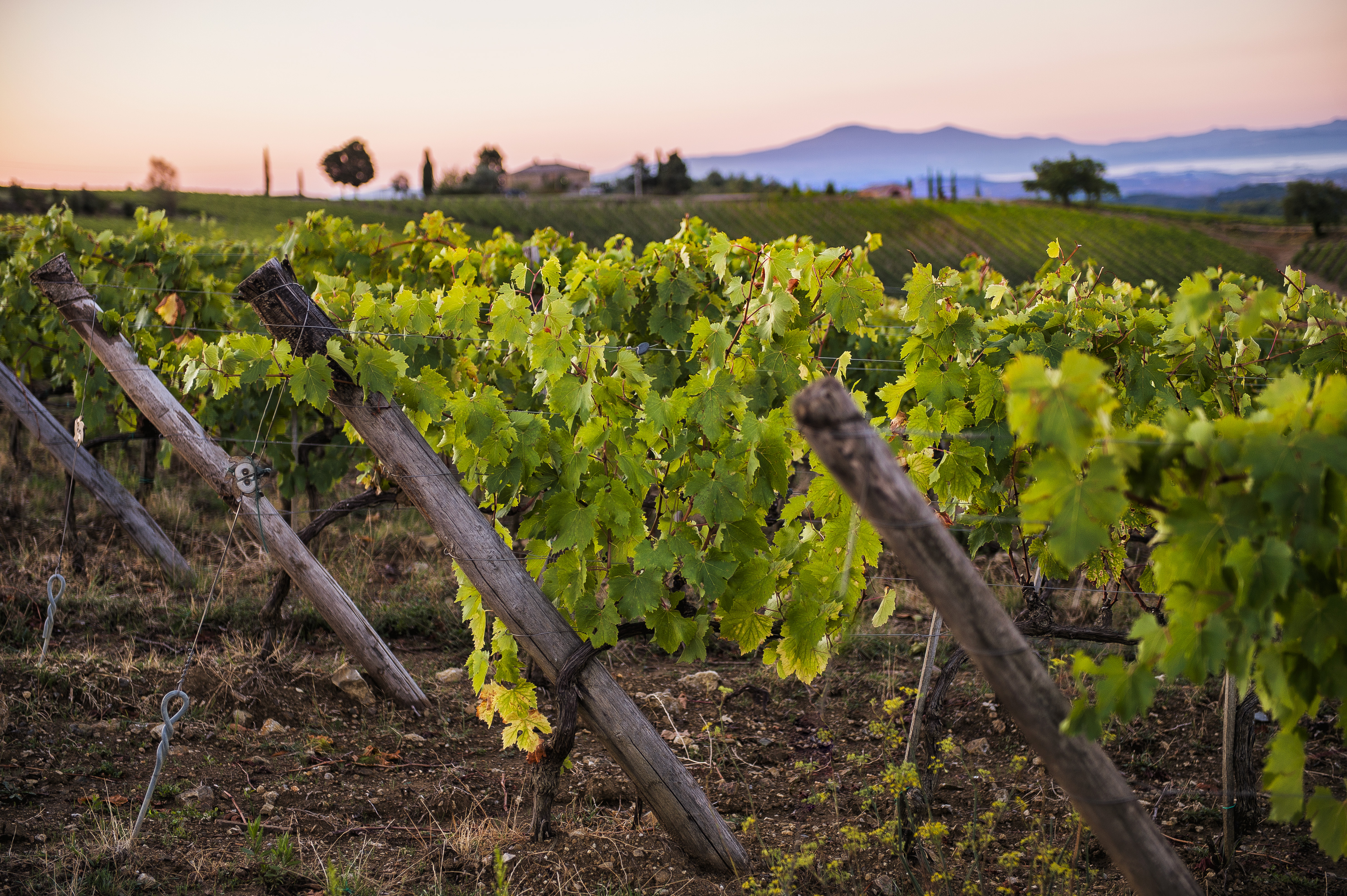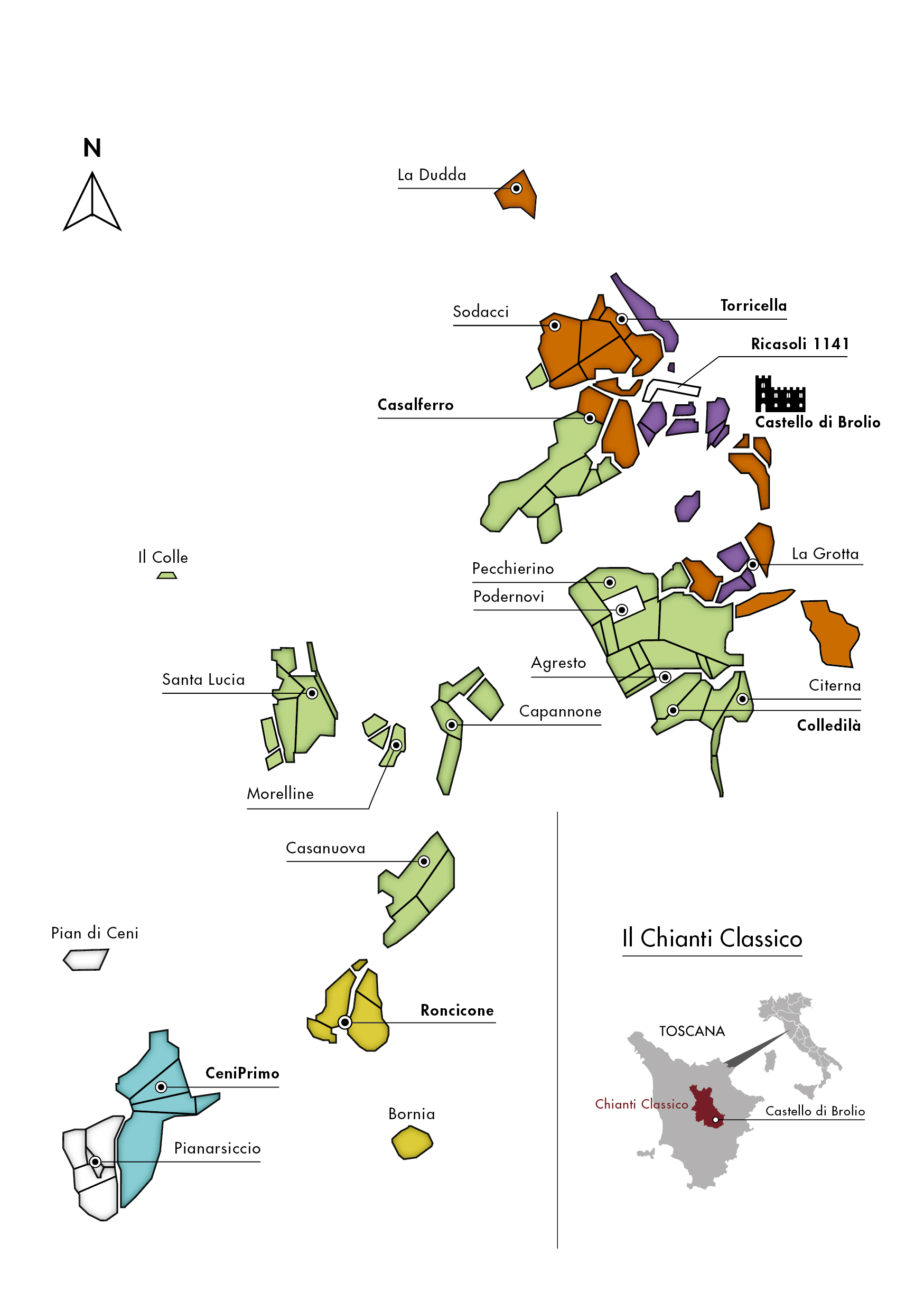
VINEYARDS AND GRAPE VARIETIES
Territorial extension and varietal wealth
Ricasoli’s vineyards are all on hills, with altitudes ranging from 220 to 500 meters above sea level, mostly with a south, southwest exposure. The climate is Mediterranean, with concentrated rainfall in spring and autumn (about 32 inches per year), mild winters with rare snowfalls, and hot, dry summers.
Sangiovese is the reigning variety; here it finds an ideal environment where it can develop all its natural potential. Attention to the terroir guides choices at Ricasoli, such as the most suitable variety to plant; the most appropriate rootstock; correct row orientation; and best agronomic practices.
Each wine we produce has a very independent personality, though all are produced in the same territory. The credit lies in the multifaceted soils, altitudes and microclimates that allow us to bring out the true nature of the Brolio Terroir.
- Francesco Ricasoli -
Soil Characteristics at Brolio
The main aim of this zonation project was to master the essential assets of the estate and land in an effort to orient both agronomic and enological choices towards best management practices to exalt modern precision in viticulture and sustainability. The zoning research that Francesco Ricasoli implemented, identified nineteen different soil types at Brolio, indicating the varied soil composition found in much of the Chianti Classico area. The wide variety typical of the Brolio vineyards is evident even to the naked eye. Wine vinified plot-by-plot has allowed us to identify areas with particular qualities and potentials and from this, wines of structure and distinctive flavor are produced. Some Crus of exceptional quality have been produced in thanks to the company’s propensity for the Cru concept.
The estate can be divided into at least five principal soil substrates:
MACIGNO DEL CHIANTI FORMATION
Soil commonly called Arenarie, composed of sand and rocks, well drained and containing little organic matter. High elevations ranging from 400 to 500 meters above sea level and variable exposure, vine-density from 5,500 to 6,600 plants per hectare. Vines: Sangiovese, Merlot, Chardonnay. The soils yield complex and well-structured wines. This area is especially well suited to viticulture and includes part of the Casalferro vineyard.
SCAGLIA TOSCANA
Also called Brolio’s argillite or Galestro (schist-based soil). The soils are very thin and the geological formations found in this area are the Scaglia Toscana and the Macigno del Chianti Formation. The altitude ranges from 400 to 500 meters above sea level, vineyard exposure to the west, northwest, and south; vine- density from 5,500 to 6,600 plants per hectare. Vines: Sangiovese. Wine with high tannin content, complex structure, and intense minerality.
MONTE MORELLO FORMATION
Limestone, commonly called Alberese. Calcareous clay soil, rocky, rich in calcium carbonate and clay and poor in organic matter. The altitude ranges from 350 to 390 meters above sea level, southeast, southern, western exposure. Vines: predominantly Sangiovese, Cabernet Sauvignon, and Merlot; vine-density is 6,600 plants per hectare. Wines: excellent structure, body, and persistence, with soft and sweet tannins. The area is ideal for Sangiovese, and includes the Colledilà vineyard.
MARINE DEPOSIT
Pliocene marine sediments, with sandy deposits and rocks smoothed by the action of the sea, and clay at deeper levels. Good levels of organic matter. Altitudes in this area range from 300 to 350 meters above sea level, variable exposure, vine-density from 5,500 to 6,600 plants per hectare. Vines: predominantly Sangiovese. Wines produced from these soils are fresh, with spicy notes, elegant acidity and distinct minerality. This area includes part of the Roncicone vineyard.
ANCIENT FLUVIAL TERRACE
Fluvial-lacustrine deposits formed in the Pliocene-Pleistocene period. The deposits are silty, poorly structured, with clay. The altitude varies between 260 to 300 meters above sea level, southwest exposure. Vines: Sangiovese and Cabernet Sauvignon, vine-density from 5,500 to 6,600 plants per hectare. Wines with a complex range of aromas, well-structured, high tannin content, body, and persistence. This area includes part of the CeniPrimo vineyard.








